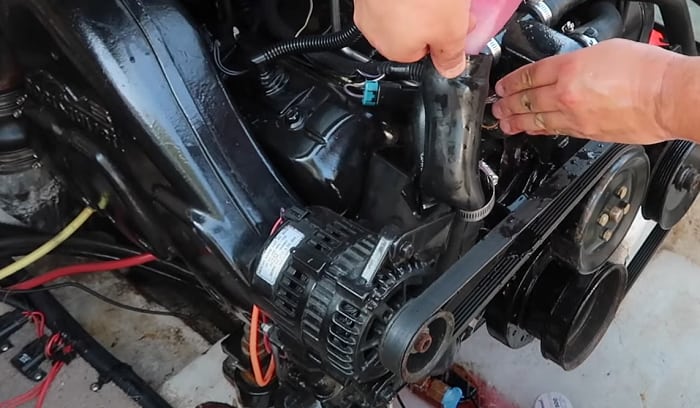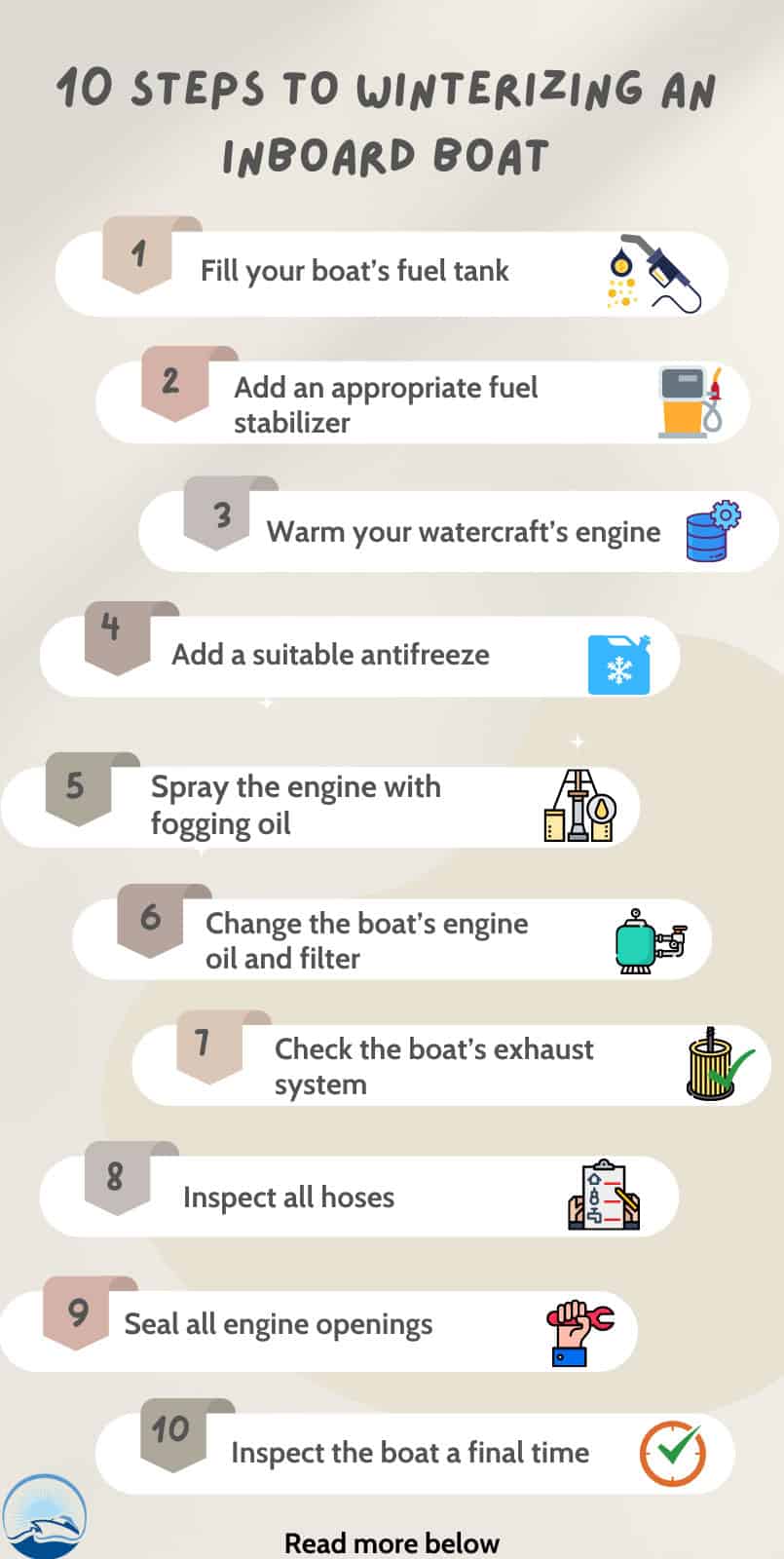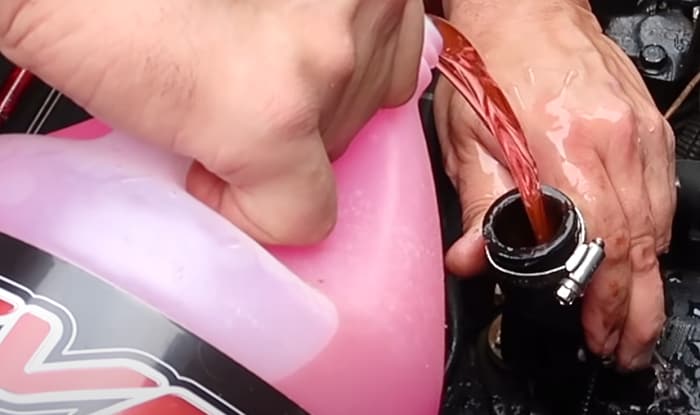Are you ready to store your inboard watercraft this winter? Learning how to winterize an inboard boat will help you keep your vessel in tip-top shape while you stay cozy and warm in your home during the cold months.
Winterizing inboard boats is an essential task all watercraft owners must know. It prevents gunk buildup and keeps condensation away from your vessel’s fuel tank. Prepping your boat for the winter also keeps the engine’s optimal operating functionality.
So, how do you prep your inboard watercraft for the winter? Read on for info on adding fuel stabilizer, using antifreeze, changing the oil filter, and more.
Table of Contents
- Things You Will Need for This Tutorial
- Steps to Winterizing an Inboard Boat
- Step 1. Fill your boat’s fuel tank.
- Step 2. Add an appropriate fuel stabilizer.
- Step 3. Warm your watercraft’s engine.
- Step 4. Add a suitable antifreeze.
- Step 5. Spray the engine with fogging oil.
- Step 6. Change the boat’s engine oil and filter.
- Step 7. Check the boat’s exhaust system.
- Step 8. Inspect all hoses.
- Step 9. Seal all engine openings.
- Step 10. Inspect the boat a final time.
- Conclusion
Things You Will Need for This Tutorial
Winterizing your inboard boat requires a few things.
1. Owner’s Manual
This essential document tells you everything about your inboard boat, including technical specifications for the engine, transmission, engine cooling system, exhaust, and more. You will also find the correct procedures for winterizing your watercraft and the recommended products to use.
2. Antifreeze
It would be best to pick an antifreeze with propylene glycol instead of ethylene glycol because it is less toxic. You will not want harmful chemicals to go into the water and kill aquatic life forms. Using propylene glycol to replace your boat’s engine coolant is also safer.
3. Fogging Oil
This product protects your carburetor and engine cylinders against corrosion. It ensures your motor will run smoothly when you operate it after winter. You can try the Star Brite Professional Grade Fogging Oil if you want.
4. Fuel Stabilizer
If your inboard boat’s engine runs on ethanol gasoline, you might want to consider adding a fuel stabilizer. This additive is essential when storing any vehicle for six months or longer. It prevents water from entering the fuel tank and keeps the fuel lines open and frost-free.
5. Other Tools and Materials
You also need a boat cover, suitable engine and transmission oils, engine oil filter, and cleaning materials.
Steps to Winterizing an Inboard Boat
Step 1. Fill your boat’s fuel tank.
Before you winterize an inboard motor, it would be best to fill the fuel tank to prevent air from getting into the fuel system.
It will be wise to remember that air contains moisture, potentially leading to condensation in low temperatures. Failure to fill the fuel tank before winter sets in can cause engine problems because there will be water in the fuel system.
Step 2. Add an appropriate fuel stabilizer.
I recommend reading your boat owner’s manual to check what fuel stabilizer you can add.
If there is no information available, I love the STAR BRITE EZ Store EZ Start Gasoline Stabilizer. This product will protect a fuel delivery system, tank, and engine during the winter.
A fuel stabilizer is crucial for keeping the full functionality of carburetors, fuel injectors, and fuel lines by protecting them against freezing.
Step 3. Warm your watercraft’s engine.
It would be best to warm your boat’s engine while it is still in the water. If not, check your watercraft to see if you can fit an adaptor and connect it to a garden hose. This procedure will help remove any debris from the vessel’s engine cooling system.
Warming your engine also circulates the fuel and stabilizer, allowing them to work wonder in protecting fuel delivery system components.
Step 4. Add a suitable antifreeze.
I suggest looking at your owner’s manual on how to add antifreeze to your boat’s engine cooling system.
Drain the old coolant from your engine block before adding an antifreeze. Some people also flush their engine cooling system to remove any trapped particulates.
You can add the antifreeze once done with the draining and flushing.
Pour non-toxic antifreeze into a five-gallon bucket. Close the intake seacock and reposition the raw water hose’s tip into the antifreeze-filled bucket.
Let your engine run at idle while you watch the system siphon the antifreeze from the bucket. You can time the process for about 30 seconds or until the container is almost empty.
Pro Tip: Keep your engine running to help circulate the antifreeze throughout the system.
Step 5. Spray the engine with fogging oil.
As the antifreeze bucket becomes nearly empty, open the boat’s carburetor and spray the fogging oil. It would be wise to remember that low-horsepower motors can stall while high-horsepower engines can sputter. These things are typical.
Note white smoke coming from the motor. Switch off the engine when there is no more antifreeze solution in the bucket.
Return the hose to its original position and secure it to the seacock.
Chris Boats has an exciting video about how to winterize a boat you might consider checking out.
Pro Tip: You can spray fogging oil straight into the combustion chamber by removing the spark plugs. There is no need to use the antifreeze bucket if you use this trick.
Step 6. Change the boat’s engine oil and filter.
Changing the engine oil and filter is an essential step to winterize inboard boat motor. The lubricant may already contain unwanted particles that can harm the motor if left to sit throughout the winter.
Turn off your engine and locate the engine oil port. Open the port and insert a tube to siphon the old engine oil. You can also use a manual pump to draw out the lubricant from the engine.
Remove the oil filter using an oil filter wrench and discard properly. Install a new oil filter and tighten it according to the manufacturer’s recommendations.
Fill your engine with new oil, keeping in mind your boat’s recommended lubrication requirements.
Pro Tip: You might also want to change your boat’s transmission oil to prepare it for winter. You can observe the same procedure, except that you will perform them on the watercraft’s transmission.
Step 7. Check the boat’s exhaust system.
Disconnect the exhaust from the manifold or water lift muffler. Inspect the hose and the exhaust system for signs of corrosion or carbon buildup. It would be best to remove these surface contaminants before storing your boat for the winter.
Inspect the raw water injection hose for signs of scale or debris. You might want to remove these, too.
Step 8. Inspect all hoses.
Cracks in hoses are excellent entry points for moisture in winter, leaving your boat vulnerable to damage. Always inspect all hoses for signs of brittleness, shredding, or cracking.
You might also want to check the hose clamps for corrosion or other forms of damage. It would be wise to replace these parts before you go into your winter quarters.
Step 9. Seal all engine openings.
Check your engine and look for possible ingress points for dirt and moisture. Cover these openings – exhaust outlets, crankcase and transmission breathers, and air inlets – with plastic caps and secure them with tape.
You might want to list all the parts you covered to make it easy to remove come springtime.
Step 10. Inspect the boat a final time.
Disconnect your battery and keep it connected to a trickle charger in your garage. Put repellents and traps in your boat to ward off rodents and prevent pest infestations.
Lubricate all joints and grease points on the motor. Remove control cables, boat accessories, devices, and other valuables.
It would be wise to cover your inboard boat with a good-quality boat cover. You might also want to use a dehumidifier to keep moisture out.
Conclusion
Knowing how to winterize an inboard boat is essential for keeping its optimal operating efficiency during storage. It keeps your watercraft in tip-top shape, ready to hit the waters as soon as the first rays of the spring sun peek.
If you find this tutorial beneficial, I know your friends will appreciate it if you share it with them. I will also be happy to hear any comments or feedback you may have.

I am passionate about water sports and technical fields, so combining both makes me interested in making contents about boat accessories. With my partner, we went on many trips and sports games together, which led us to think about how we can spread our joys and passions to many people.




